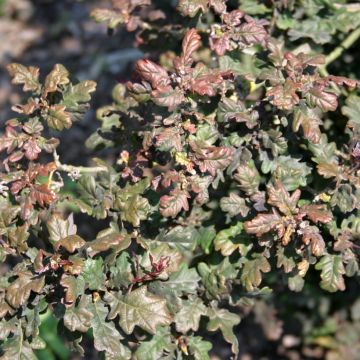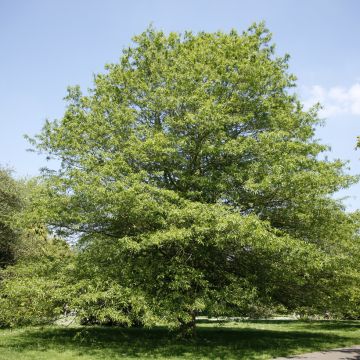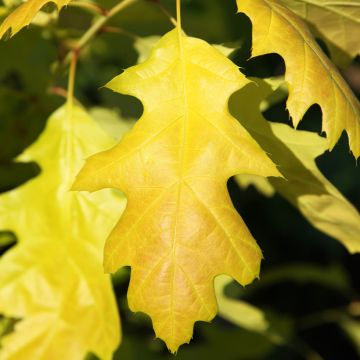

Quercus bimundorum Crimson spire


Quercus bimundorum Crimson spire


Quercus bimundorum Crimson spire
Quercus bimundorum Crimson spire
Quercus bimundorum Crimson spire
Oak
Special offer!
Receive a €20 voucher for any order over €90 (excluding delivery costs, credit notes, and plastic-free options)!
1- Add your favorite plants to your cart.
2- Once you have reached €90, confirm your order (you can even choose the delivery date!).
3- As soon as your order is shipped, you will receive an email containing your voucher code, valid for 3 months (90 days).
Your voucher is unique and can only be used once, for any order with a minimum value of €20, excluding delivery costs.
Can be combined with other current offers, non-divisible and non-refundable.
Why not try an alternative variety in stock?
View all →This plant carries a 24 months recovery warranty
More information
We guarantee the quality of our plants for a full growing cycle, and will replace at our expense any plant that fails to recover under normal climatic and planting conditions.
Would this plant suit my garden?
Set up your Plantfit profile →
Description
Quercus bimundorum Crimson Spire is a very beautiful columnar oak tree, perfect for avenues or as a standalone specimen. It quickly reaches a height of 10m (33ft) and can grow up to 15m (49ft) when mature, while its narrow width (3m (10ft) after 10 years, 5m (16ft) at maturity) makes it suitable for planting in even small gardens. Its beautiful green foliage turns to orange-red in autumn, transforming this oak tree into a colourful torch as winter approaches. The marcescent leaves persist on the branches until new shoots emerge in the following spring. With fast growth and good resistance to diseases that can affect certain oak trees, it is a variety to prioritise in the garden.
Oak trees belong to the Fagaceae family, which includes other noble tree species such as chestnuts and beeches. These trees have great ecological importance in their natural habitat, and humans owe them a lot on an economic level (land constructions, ships...). The Quercus genus is so rich that entire books are dedicated to it; in addition to the deciduous species that are familiar to us, there are also evergreen species with a surprising diversity of forms. In temperate climates, European oaks are traditionally distinguished from American oaks, but some species grow as far as the tropical regions of Asia.
Quercus x bimundorum Crimson Spire is a hybrid between European and American oaks that has taken the best features from both parents. Morphologically very similar to the European Quercus robur 'Fastigiata', from which it borrowed its columnar habit, it also benefits from the rich orange-red autumn foliage of its American parent, Quercus alba. It is also resistant to mildew and powdery mildew, allowing it to maintain healthy foliage throughout the season.
This tree should be planted in a sunny location with moist, neutral pH soil. It is highly frost resistant, down to -25°C (-13°F) and will thrive in any good garden soil with sufficient nutrients, as long as it does not dry out in summer.
The 'Crimson Spire' oak has an interesting architectural habit for French or contemporary gardens. In its young age, it forms a well-defined column, measuring 10m (33ft) in height and 3m (10ft) in width at 10 years old. It then slightly widens to take on an oval shape, forming a tree that is 15m (49ft) tall and 5m (16ft) wide, ideal for bordering a pathway, being the centrepiece of a bed, or as a specimen in a lawn. The leaves have indistinct lobes and are dark green in colour. In autumn, they gradually turn orange-red, and even purple.
It can be happily associated with other woody plants with yellow or golden foliage, such as the Cercis 'Hearts of Gold', whose pretty heart-shaped leaves change colour throughout the year (from red to lime green to yellow) and will stand out in terms of shape and shade compared to our oak tree. A golden Physocarpus will also be a great companion to create a contrast of colors...
Its elegant and regular shape will blend harmoniously with other woody plants shaped into topiaries (cushions, cloud-shaped trees...) in gardens where overall volumes and shapes take precedence over the individuality of each plant.
Quercus bimundorum Crimson spire in pictures


Plant habit
Flowering
Foliage
Botanical data
Quercus
bimundorum
Crimson spire
Fagaceae
Oak
Cultivar or hybrid
Other Oak
View all →Planting and care
Quercus x bimundorum 'Crimson Spire' grows in ordinary but deep soil, with a slightly acidic pH. It thrives best in full sun. When planting, it is advisable to add compost to the bottom of the hole to enrich the existing soil. Plant preferably in autumn and water abundantly. Monitor watering during the first two years, especially in summer, to prevent the soil from drying out.
Apply organic food in spring to promote growth from the second year, once the roots have started to colonise the soil.
Once established, it is a sturdy tree, not susceptible to powdery mildew, which covers the leaves of certain oak species with an unsightly white film that impairs photosynthesis. Similarly, it is resistant to downy mildew and can tolerate partial coverage of the soil by paving, allowing it to be planted along pathways.
Planting period
Intended location
Care
Planting & care advice
This item has not been reviewed yet - be the first to leave a review about it.
Haven't found what you were looking for?
Hardiness is the lowest winter temperature a plant can endure without suffering serious damage or even dying. However, hardiness is affected by location (a sheltered area, such as a patio), protection (winter cover) and soil type (hardiness is improved by well-drained soil).

Photo Sharing Terms & Conditions
In order to encourage gardeners to interact and share their experiences, Promesse de fleurs offers various media enabling content to be uploaded onto its Site - in particular via the ‘Photo sharing’ module.
The User agrees to refrain from:
- Posting any content that is illegal, prejudicial, insulting, racist, inciteful to hatred, revisionist, contrary to public decency, that infringes on privacy or on the privacy rights of third parties, in particular the publicity rights of persons and goods, intellectual property rights, or the right to privacy.
- Submitting content on behalf of a third party;
- Impersonate the identity of a third party and/or publish any personal information about a third party;
In general, the User undertakes to refrain from any unethical behaviour.
All Content (in particular text, comments, files, images, photos, videos, creative works, etc.), which may be subject to property or intellectual property rights, image or other private rights, shall remain the property of the User, subject to the limited rights granted by the terms of the licence granted by Promesse de fleurs as stated below. Users are at liberty to publish or not to publish such Content on the Site, notably via the ‘Photo Sharing’ facility, and accept that this Content shall be made public and freely accessible, notably on the Internet.
Users further acknowledge, undertake to have ,and guarantee that they hold all necessary rights and permissions to publish such material on the Site, in particular with regard to the legislation in force pertaining to any privacy, property, intellectual property, image, or contractual rights, or rights of any other nature. By publishing such Content on the Site, Users acknowledge accepting full liability as publishers of the Content within the meaning of the law, and grant Promesse de fleurs, free of charge, an inclusive, worldwide licence for the said Content for the entire duration of its publication, including all reproduction, representation, up/downloading, displaying, performing, transmission, and storage rights.
Users also grant permission for their name to be linked to the Content and accept that this link may not always be made available.
By engaging in posting material, Users consent to their Content becoming automatically accessible on the Internet, in particular on other sites and/or blogs and/or web pages of the Promesse de fleurs site, including in particular social pages and the Promesse de fleurs catalogue.
Users may secure the removal of entrusted content free of charge by issuing a simple request via our contact form.
The flowering period indicated on our website applies to countries and regions located in USDA zone 8 (France, the United Kingdom, Ireland, the Netherlands, etc.)
It will vary according to where you live:
- In zones 9 to 10 (Italy, Spain, Greece, etc.), flowering will occur about 2 to 4 weeks earlier.
- In zones 6 to 7 (Germany, Poland, Slovenia, and lower mountainous regions), flowering will be delayed by 2 to 3 weeks.
- In zone 5 (Central Europe, Scandinavia), blooming will be delayed by 3 to 5 weeks.
In temperate climates, pruning of spring-flowering shrubs (forsythia, spireas, etc.) should be done just after flowering.
Pruning of summer-flowering shrubs (Indian Lilac, Perovskia, etc.) can be done in winter or spring.
In cold regions as well as with frost-sensitive plants, avoid pruning too early when severe frosts may still occur.
The planting period indicated on our website applies to countries and regions located in USDA zone 8 (France, United Kingdom, Ireland, Netherlands).
It will vary according to where you live:
- In Mediterranean zones (Marseille, Madrid, Milan, etc.), autumn and winter are the best planting periods.
- In continental zones (Strasbourg, Munich, Vienna, etc.), delay planting by 2 to 3 weeks in spring and bring it forward by 2 to 4 weeks in autumn.
- In mountainous regions (the Alps, Pyrenees, Carpathians, etc.), it is best to plant in late spring (May-June) or late summer (August-September).
The harvesting period indicated on our website applies to countries and regions in USDA zone 8 (France, England, Ireland, the Netherlands).
In colder areas (Scandinavia, Poland, Austria...) fruit and vegetable harvests are likely to be delayed by 3-4 weeks.
In warmer areas (Italy, Spain, Greece, etc.), harvesting will probably take place earlier, depending on weather conditions.
The sowing periods indicated on our website apply to countries and regions within USDA Zone 8 (France, UK, Ireland, Netherlands).
In colder areas (Scandinavia, Poland, Austria...), delay any outdoor sowing by 3-4 weeks, or sow under glass.
In warmer climes (Italy, Spain, Greece, etc.), bring outdoor sowing forward by a few weeks.



























































